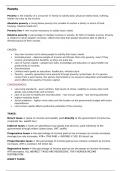Poverty
Poverty = the inability of a consumer or family to satisfy basic physical needs (food, clothing,
shelter etc) due to low income.
Absolute poverty = living below poverty line (unable to sustain a family in terms of food,
housing, medical needs etc)
Poverty line = min income necessary to satisfy basic needs
Relative poverty = percentage of median incomes in society. Ex 50% of median income. Poverty
is relative to other people’s incomes; reflects the idea that people should be able to afford a
lifestyle typical of their society.
CAUSES:
Very low incomes not to allow people to satisfy their basic needs
Unemployment – deprives people of income and throws them into poverty, even if they
receive unemployment benefits, as they are quite low
Lack of human capital – people lack skills, knowledge and education or good health low
productivity & incomes.
Discrimination
Limited merit goods ex education, healthcare, infrastructure
Poverty – poverty generates more poverty through poverty cycles/traps. Ex if a person
comes from a poor family, this person has limited or no access to education and healthcare
and it affects the quality of human capital.
CONSEQUENCES:
Low living standards – poor nutrition, high levels of stress, inability to access vital merit
goods, low productivity and incomes
Lack of access to healthcare and education – low human capital – low earning potential
Higher mortality levels
Social problems – higher crime rates and the burden on the government budget with extra
expenditures
Low human capital affects productive potential of the economy
TAXES:
Direct taxes = taxes on income and wealth, paid directly to the government (income tax,
corporate tax, wealth tax)
Indirect taxes = taxes on spending to buy goods and services, paid indirectly to the
government through sellers (sales taxes, VAT, tariffs)
Progressive taxes = the percentage of income paid as tax increases as income increases.
Average tax rate increases. ATR= (TAX PAID ÷ INCOME) X 100. EX direct tax
Proportionate taxes = the percentage of income paid as tax remains constant as income
increases. ATR is constant. EX direct tax
Regressive taxes = the percentage of income paid as tax decreases as income increases.
ATR decreases. ALL INDIRECT TAXES ARE REGRESSIVE. THEY WORSEN INCOME
DISTRIBUTION.
DIRECT TAXES:
, Personal income taxes – taxes paid by households (or individuals in households), paid on all forms of
income
Corporate income taxes – taxes on the profits of corporations (firms that have formed a legal body)
Wealth taxes – taxes on the ownership of assets
E.g. property taxes, inheritance taxes
Social insurance taxes (social security) – paid by workers & employers (on behalf of employees),
paid into specific funds such as pension, social insurance, or healthcare
Promoting equality in income distribution:
• Progressive taxes. The more progressive a tax system (the more rapidly ATR increases as
income rises), the greater the income redistribution achieved: increasingly larger
proportions of income are taxed away ∴ decreasing the income differences between rich
and poor. The resulting tax revenues can be used to provide merit goods and transfer
payments
• Direct provision of merit goods or subsidizing merit goods – includes education,
healthcare and infrastructure (clean water, sanitation, sewage etc), making the available to
people on low incomes who would otherwise be unable to have access to them
• Transfer payments (transfers of income from taxpayers to vulnerable groups, who are
people in need). This includes unemployment benefits, child allowances, pensions
• Price controls. Ex price floors to support incomes of farmers and low-skilled workers
(minimum wages), and price ceilings to make food, rents more affordable




